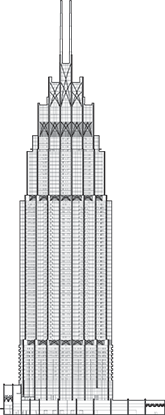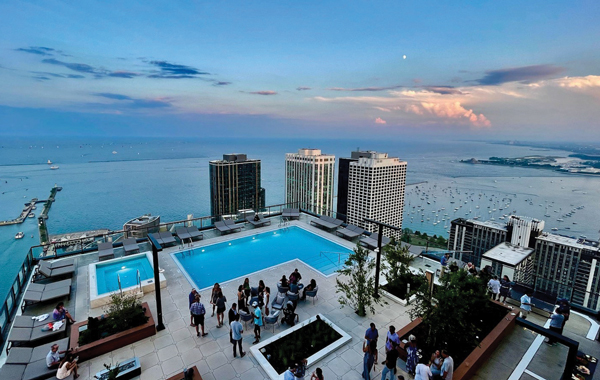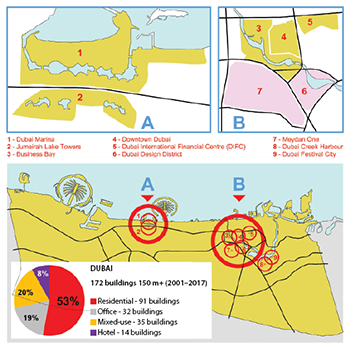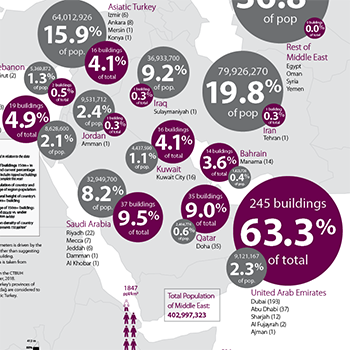Filter by
You must be a CTBUH Member to view this resource.

The Address Boulevard
The Address Boulevard Hotel, The Address The BLVD, The Address Boulevard Dubai
Building
Completed
2017
Residential / Hotel / Retail
All-Concrete
370 m / 1,214 ft
73
3
530
196
6 m/s
You must be a CTBUH Member to view this resource.
You must be a CTBUH Member to view this resource.
Proposed
Construction Start
Completed
Usually takes on the balance of the architectural effort not executed by the "Design Architect," typically responsible for the construction documents, conforming to local codes, etc. May often be referred to as "Executive," "Associate," or "Local" Architect, however, for consistency CTBUH uses the term "Architect of Record" exclusively.
The Design Engineer is usually involved in the front end design, typically taking the leadership role in the Schematic Design and Design Development, and then a monitoring role through the CD and CA phases.
The CTBUH lists a project manager when a specific firm has been commissioned to oversee this aspect of a tall building’s design/construction. When the project management efforts are handled by the developer, main contract, or architect, this field will be omitted.
The main contractor is the supervisory contractor of all construction work on a project, management of sub-contractors and vendors, etc. May be referred to as "Construction Manager," however, for consistency CTBUH uses the term "Main Contractor" exclusively.
Other Consultant refers to other organizations which provided significant consultation services for a building project (e.g. wind consultants, environmental consultants, fire and life safety consultants, etc).
These are firms that consult on the design of a building's façade. May often be referred to as "Cladding," "Envelope," "Exterior Wall," or "Curtain Wall" Consultant, however, for consistency CTBUH uses the term "Façade Consultant" exclusively.
Material Supplier refers to organizations which supplied significant systems/materials for a building project (e.g. elevator suppliers, facade suppliers, etc).
You must be a CTBUH Member to view this resource.
Usually involved in the front end design, with a "typical" condition being that of a leadership role through either Schematic Design or Design Development, and then a monitoring role through the CD and CA phases.
Usually takes on the balance of the architectural effort not executed by the "Design Architect," typically responsible for the construction documents, conforming to local codes, etc. May often be referred to as "Executive," "Associate," or "Local" Architect, however, for consistency CTBUH uses the term "Architect of Record" exclusively.
The Design Engineer is usually involved in the front end design, typically taking the leadership role in the Schematic Design and Design Development, and then a monitoring role through the CD and CA phases.
The CTBUH lists a project manager when a specific firm has been commissioned to oversee this aspect of a tall building’s design/construction. When the project management efforts are handled by the developer, main contract, or architect, this field will be omitted.
The main contractor is the supervisory contractor of all construction work on a project, management of sub-contractors and vendors, etc. May be referred to as "Construction Manager," however, for consistency CTBUH uses the term "Main Contractor" exclusively.
Other Consultant refers to other organizations which provided significant consultation services for a building project (e.g. wind consultants, environmental consultants, fire and life safety consultants, etc).
These are firms that consult on the design of a building's façade. May often be referred to as "Cladding," "Envelope," "Exterior Wall," or "Curtain Wall" Consultant, however, for consistency CTBUH uses the term "Façade Consultant" exclusively.
Material Supplier refers to organizations which supplied significant systems/materials for a building project (e.g. elevator suppliers, facade suppliers, etc).
28 November 2018 - CTBUH Research
13 October 2016 - CTBUH Research

22 August 2022
S. Isaac Work & Shawn Ursini, Council on Tall Buildings and Urban Habitat
Tall building design has diversified and adapted to accommodate increased demand for distinctive amenities at a range of heights. Swimming pools are a classic feature...
The Address Boulevard is one of the tallest buildings in Downtown Dubai, located next to Burj Khalifa. The hotel and residential tower is situated with convenient access to Mohammed Bin Rashid Boulevard, and near The Opera District, a cultural hub of the region. Crowned by two matching spires, the tower has a 196-room hotel operated by The Address Hotels + Resorts, and 530 serviced apartments. Residents and guests may enjoy stunning views of Burj Khalifa, The Dubai Fountain, and the Arabian Sea.
The structure sits on a multi-level podium, with the upper level providing separate lobbies for the hotel and serviced apartments. The podium base creates a protective wall separating the tower from the boulevard and the raised highway to the north, which works to minimize noise disturbance. In an elliptical shape, the tower’s gentle curves ensure that all apartments and guestrooms have unobstructed views of Downtown Dubai and beyond. The stepped ellipse form also lends a dynamic appearance to the building, with its proportions constantly shifting, depending on the vantage point.
Projected vertical fins act as blades that cut through the top of the building, creating a visual link between the two main façades. These fins, in conjunction with the balconies, provide both horizontal and vertical shading, which enhances the building’s thermal performance and helps reduce HVAC loads, relative to the region. The building’s façade utilizes a high- performance unitized system that aims to provide superior solar and thermal performance.
An enclosed moving walkway joins the tower to the Dubai Metro, The Dubai Mall, and other key developments. This increased mobility for guests and residents ties the structure into a greater urban context, connecting it with the rapidly expanding metropolis.

22 August 2022
S. Isaac Work & Shawn Ursini, Council on Tall Buildings and Urban Habitat
Tall building design has diversified and adapted to accommodate increased demand for distinctive amenities at a range of heights. Swimming pools are a classic feature...

20 October 2018
Elena M. Generalova & Viktor P. Generalov, Samara State Technical University
This study discusses the current typologies of high-rise housing prevalent in Dubai. The uniqueness, trends and prospects of Dubai tall, residential development are analyzed. The...

20 October 2018
CTBUH Research
The Middle East region is hosting its first CTBUH International Conference since 2008. In that year, there were 119 completed buildings of 150 meters or...
Tim Griffith for KPF.jpg)
05 February 2018
This 2017 Tall Building Year in Review / Tall Buildings in Numbers data analysis report shows that more buildings of 200 meters’ height or greater...
28 November 2018
CTBUH has released a Tall Buildings in Numbers (TBIN) interactive data study examining the relationship between high-rise growth and population in the Middle East.
13 October 2016
The Council is pleased to announce the Top Company Rankings for numerous disciplines as derived from the list of projects appearing in 100 of the World’s Tallest Buildings.
Subscribe below to receive periodic updates from CTBUH on the latest Tall Building and Urban news and CTBUH initiatives, including our monthly newsletter. Fields with a red asterisk (*) next to them are required.
View our privacy policy